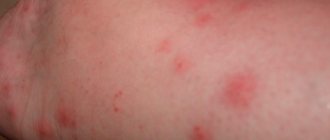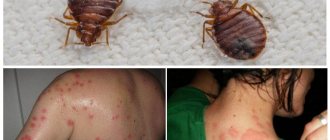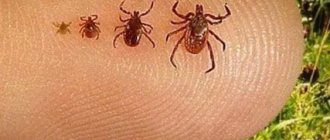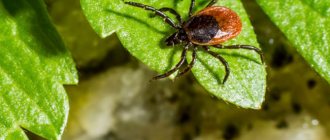The peak activity of ticks in Russia occurs in May-June. During these same months, the peak incidence of tick-borne infections is usually recorded. As Rospotrebnadzor reported on June 16, the number of calls to medical organizations for victims of tick bites this year does not exceed the long-term average.
According to the federal service, in 2022, 16,250 Russians turned to doctors with complaints of tick bites. In total, over the past year, 329 cases of tick-borne infections were identified in the country.
In nature, there are over 50 thousand species of these arthropod arachnids, but most of them do not pose a threat to humans. Only three types of ticks are dangerous to people and animals: ixodid, argasso and gamas, because they are attracted by the heat of a living organism.
What new type of dangerous ticks has appeared in Russia? More details
The most numerous of these species are ixodid ticks. On the territory of our country you can find such representatives as Ixodes, Haemaphysalis, Dermacentor, Hyalomma, Rhipicephalus. They are carriers of the tick-borne encephalitis virus, tularemia and other dangerous diseases.
Taiga tick (lat. Ixodes persulcatus)
The taiga tick is considered one of the main carriers of tick-borne encephalitis and Borrelia, the causative agents of Lyme borreliosis. It lives in the Moscow, Leningrad, Ulyanovsk and Samara regions, within the middle and southern subzones of the taiga, in the southern regions of Karelia and Kamchatka, on Sakhalin, the Far East and in other regions of the country.
Typically, taiga ticks do not climb to a height of more than one meter. They can be found in the grass along forest paths and roads, especially in the taiga, mixed forests, spruce forests and in the forest-steppe zone. However, these ticks can also lie in wait in green areas of cities, in summer cottages, in parks and squares, in cemeteries and other places.
Is it possible to distinguish an encephalitis tick from a regular one?
Ticks are only a few millimeters in size; their bodies enlarge as they become saturated with blood. The female is larger than the male, brown or light brown in color with a flattened body when hungry. Externally, the encephalitis tick is no different
from the usual, therefore, after removing the parasite from the wound, it must be preserved and urgently taken for examination to a medical center, where they will conduct a study to determine whether the tick was infected or not.
Forest tick (lat. Ixodes ricinus)
The forest tick (also known as the dog tick, the European forest tick and the cattle tick) is especially likely to carry tick-borne encephalitis and borrelia, which are dangerous to humans. In addition, its bite can cause diseases such as Q fever (accompanied by general toxic phenomena, fever and often atypical pneumonia), babesiosis (characterized by severe fever, enlarged liver and spleen), tularemia, relapsing tick-borne fever and granulocytic anaplasmosis (accompanied by high fever and general intoxication) and other infections of animals and humans.
Like other arthropods, this tick usually lives in the forest, but can also be found in meadows and bushes. The forest tick is especially common in the European part of Russia.
Can ticks and mosquitoes spread coronavirus? More details
What should I do if bitten by a tick?
If it turns out that the tick has already bitten, you need to urgently remove it from the surface of the skin. This can be done with your own hands or at a medical center. The second option is safer, plus the emergency room workers will immediately send the parasite for examination to a laboratory, if available.
The sooner a person notices and removes a tick, the less likely it is that it will become infected.
If it is not possible to contact a specialist, you can remove the tick yourself at home. It is worth remembering: when removing a tick from the skin, it is important not to crush it, so that the insides do not fall into the open wound. Grab the tick's body with tweezers close to the surface of the skin, next to the head, and gently twist it counterclockwise. If you don’t have tweezers at hand, you can use ordinary thread - make a loop out of it and tie it around the parasite, then smoothly pull it out.
There is also a folk remedy - drop oil on the tick. We don't recommend doing this. Firstly, the likelihood that the tick will come out on its own after this procedure is extremely low; rather, it will try to burrow even deeper under the skin. And secondly, this method can kill the parasite, and it is important for us to deliver it to the laboratory alive.
After the bloodsucker is removed, the bite site should be treated with an alcohol solution. The parasite and its parts should be placed in a small jar or other container with a couple of drops of water on a piece of cotton wool. This will save it. After which you need to deliver the tick for examination, the results of which will be known in about two days. The analysis will reveal whether it is a simple tick or one infected with encephalitis.
If you have been vaccinated against tick-borne encephalitis, then if you are bitten, you should simply remove it. No additional research is required.
Infection with encephalitis is similar to the onset of the influenza virus. It is characterized by muscle weakness, fever, increased temperature, chills, nausea with vomiting and pain when moving in the limbs. There is also a headache, especially in the temples and frontal part, thirst, dry mouth and all this is accompanied by pain in the eye sockets.
Pasture mite (lat. Dermacentor marginatus)
An encounter with a pasture tick can result in infection with tick-borne encephalitis, Omsk hemorrhagic fever, tularemia, listeriosis, Q fever and other diseases. Typically this species parasitizes cattle, but adult individuals often “attack” people.
The pasture tick lives in the south of the European part of Russia, Western Siberia, Crimea, the Caucasus (including Transcaucasia), and the Middle and Lower Volga regions. It is usually found in mountain-steppe regions, but can also live in forest-steppe and mountain-forest areas.
Statistics of encephalitis infection in Russia
In 2022, 23 people (according to Rospotrebnadzor) from 12 constituent entities of the Russian Federation died from a tick bite followed by encephalitis. In 2022, more than 560,000 visits to medical attention were recorded from people bitten by ticks. This figure is higher than last year and generally exceeds the annual average. The total number of people infected with tick-borne encephalitis was 1,523 people.
Every year, from 2010 to 2022, an average of 29 to 50 deaths from viral tick-borne encephalitis are recorded.
The main causes of complications and death from encephalitis are neglect of vaccination and late consultation with a doctor. The sanitary treatment areas increase every year, but the number of victims does not decrease.
44% of those infected with tick-borne encephalitis are people over 50 years of age.
In the Moscow region, from 2015 to 2022, 41 cases of tick-borne encephalitis were identified, all of them certified by the laboratory. There were also 14 cases where the virus was accidentally brought from other regions of Russia. As statistics show, vacationers mainly catch the infection when they go on vacation in the region to nature. Since 2003, cases of a local nature began to be recorded; for 2015-2017, this figure reached 113 registered cases out of 2873 available. For 2022, the percentage of people infected with encephalitis, namely 62%, occurred in the capital of the Russian Federation - Moscow and the region.
According to data for all past years, a greater number of infected people were noted in the Republic of Tyva. The table shows statistics with the highest rates.
| Locality in the Russian Federation | % per 100 thousand population |
| Tyva Republic | 23,5 |
| Vologda | 23,04 |
| The Republic of Khakassia | 12,8 |
| Kirov region | 15,07 |
| Sverdlovsk region | 12,2 |
Pavlovsky's mite (lat. Ixodes pavlovskyi)
Pavlovsky's mite was first identified in Russia in the mid-twentieth century in the Far East. However, subsequently it began to be detected in Western Siberia, and isolated cases were also recorded in Eastern Siberia.
Question answer
Will the number of ticks increase in the summer of 2022? Today, this tick is represented in the country by two subspecies: I. pavlovskyi pavlovskyi Pomerantsev, which lives in the Far East, as well as the Siberian I. pavlovskyi occidentalis Filippova and Panova. The latter is widespread in the lowland areas of the Novosibirsk and Tomsk regions. Experts note that in some areas the Pavlovsky tick has almost completely replaced the taiga tick, with which it has much in common. The Pavlovsky tick is also a carrier of the same infectious agents - encephalitis and borrelia.
Meet the Ixodid tick
Many ixodid ticks have only light-sensitive cells instead of eyes, so they use other senses to “hunt.”
At long distances the main role is played by the multifunctional Haller organ
, with the help of which ticks are able to perceive changes in the concentration of carbon dioxide, specific components of the smell of a potential host (hydrogen sulfide, ammonia) and its thermal radiation at a distance of up to 10 m. Having reached the “victim”, ticks determine the most suitable place for suction using sensitive sensilla, consisting of cuticular hair and receptor cells, which are especially numerous on the paws and mouthparts.
Ticks are often mistakenly called insects, but it is easy to distinguish a potential bloodsucker from a harmless bug: adult ticks have eight legs, like spiders, and not six, like insects. Together with spiders, mites form the class of arachnids (Arachnida), which, along with crustaceans, insects and centipedes, is included in the phylum of arthropods (Arthropoda). Today, more than 50 thousand different types of ticks are known, many of which are parasites, although not all of them pose a danger to humans or domestic animals. The ixodid tick family Ixodidae includes six main genera: Ixodes
(249 species),
Haemaphysalis
(166),
Amblyomma
(142),
Rhipicephalus
(79),
Dermacentor
(36),
Hyalomma
(25 species).
The Latin name of each tick consists of two parts: an indication of the genus and species, and well-studied species also have a Russian name. For example, taiga tick
(
Ixodes persulcatus
),
meadow tick
(
Dermacentor reticulatus
).
Ixodid ticks are the largest of all ticks: adults reach 2–13 mm in length. The most common taiga tick in Russia, I. persulcatus,
has a body length of 3–4 mm for a hungry female, 2–3 mm for a male, 1.2–1.7 mm for a nymph, and less than 1 mm for a larva. The size of engorged ticks is significantly larger
The paired salivary glands of the tick secrete a secret containing many biologically active components that act as an analgesic, prevent blood clotting, suppress the host's immune responses, stimulate the release of histamine by the host's cells, etc. They can also secrete components of the cement sheath involved in fixing the tick on the body owner.
Another unique function of the salivary glands is osmoregulation. When there is a threat of drying out, hygroscopic saliva is secreted into the pre-oral cavity of the tick, which adsorbs water molecules from the air, which allows the tick to retain the necessary moisture in the body and remain viable for many months between blood meals. And, on the contrary, when feeding on blood, the tick is able to return about 70% of the “excess” absorbed water and salts by salivating at the bite site. As a result, the volume of saliva secreted by the tick during the entire feeding period significantly exceeds the body weight of the engorged tick (Biology of Ticks, 2014).
The body of the ixodid tick consists of two sections: an unsegmented body, bearing legs (6 in larvae, 8 in nymphs and adult males and females), and a head. On the dorsal side there is a hard shield, which in females, nymphs and larvae covers only the anterior third or half of the body. The rest is covered with an extensible cuticle, which in hungry individuals forms a system of parallel microfolds that straighten during feeding.
Most ixodid ticks are characterized by the grazing-lurking type.
parasitism: hungry individuals climb onto vegetation, where they lie in wait for potential hosts passing by. Having received the necessary signals, the tick goes into a state of “active lurking,” making oscillatory movements with the first pair of legs extended forward until direct contact with the host animal.
For many ticks of the genus Ixodes
The nest-burrow type
is characteristic , when hungry individuals at all stages of development attack potential hosts in burrows and nests;
some have a mixed type of parasitism. There are also ticks adapted to living in houses, for example, the dog tick Rhipicephalus sanguineus
(Balashov, 1998; Yakimenko, 2013; Biology of Ticks, 2014).
Hybrid of the Taiga tick (lat. Ixodes persulcatus) and Pavlovsky tick (lat. Ixodes pavlovskyi)
Information about the hybrid first appeared in 2009. It was confirmed in June 2022, after Russian scientists sequenced (i.e. deciphered) the arthropod genome. According to the journal of the Siberian Branch of the Russian Academy of Sciences “Science in Siberia”, the new species could have formed due to the fact that both types of ticks live in the same territory.
The danger of a hybrid lies in the fact that it is a carrier of all diseases carried by the parent species. This is a tick-borne encephalitis virus, various types of Borrelia, Rickettsia (intracellular parasites that cause acute febrile diseases, including epidemic typhus), Ehrlichia (affect the skin, liver, central nervous system and bone marrow, forming infectious granulomas in these organs), Anoplasma (pathogen blood disease granulocytic anaplasmosis, which is accompanied by high fever and general symptoms of intoxication), as well as Babesia (intracellular parasites that attack red blood cells), which especially often infect dogs.
You can encounter these ticks in May-June in the Novosibirsk region in deciduous and mixed forests, valleys of forest rivers and streams.
In which regions do tick-borne encephalitis occur most often? More details
Habitats
Ticks belong to the class of arachnids, are small in size (from 2 to 5 mm) and live almost all over the world. There are about 700 species in total.
Most ticks prefer to settle in deciduous forests, in lowlands with high humidity, and in wetlands. The main condition is tall and thick grass. They can live on low trees and bushes. For the most part, ticks feed on the blood of warm-blooded animals.
Some species coexist with humans. For example, saprophytes, that is, dust mites. They feed on dead skin particles. There are also mites that live directly on the body - demodexes. They live in the upper layer of the epidermis and near the hair follicles. Subcutaneous mites are so small that they are impossible to see with the naked eye.
How to treat a bitten area
After a tick bite, there are three possible scenarios. The set of actions of the victim and his relatives depends on this:
- There is no insect. It is enough to disinfect the wound with alcohol, chlorhexidine or any other antiseptic. If soap and water are available nearby, it is best to rinse the area first.
- The head remained in the body. You won't be able to pull it out on your own. Lubricating with oil or greasy cream will do nothing. It is enough to treat it with an iodine solution - and you can wait until the head dries and comes out.
- The tick has attached itself and is holding on.
If the hospital is far away, you should pull it out yourself. To do this, grab the insect with tweezers as close to the head as possible and pull it, turning it around its axis. After this, we treat the wound as in the first option. The bitten area may itch, especially if the victim is prone to allergies. You can't comb it. To relieve itching, it is better to take an antihistamine.
How does a tick get to a person?
Most species of ticks have extremely poor vision, with which they can only distinguish shadows. No images, colors or other privileges available to a person. However, evolution has awarded these insects with a much more formidable weapon - hypersensitivity.
They respond well to the slightest changes in temperature, movement, various odors (including those of humans), changes in humidity, and are able to pick up vibrations. Usually, to find a victim, a tick climbs onto bushes or grass and freezes in anticipation, with its front legs spread wide.
Interesting fact! Sensors, located mainly on the legs of the tick, are able to detect the smell and movement of the animal (human) at a distance of 8-10 meters.
The most comfortable conditions for living and hunting are forests with tall grass, and less often fields . As soon as the victim approaches the tick, it will immediately grab onto the person’s clothing, skin or hair. As for the ability to cling, ticks have no equal.
Next, the tick looks for a place to bite, choosing mainly areas with thinner skin: on the neck, groin, behind the ear, etc.
How dangerous are ticks for humans?
As mentioned above, a tick bite can trigger the development of various infectious diseases. Some diseases are more dangerous and can even lead to death or disability. Others are not as dangerous, but still require medical treatment using appropriate medications.
Tick-borne encephalitis
The worst thing that can happen to a person who is bitten by a tick is infection with tick-borne encephalitis . This is a dangerous disease that, if not treated appropriately and promptly, can lead to death. Sometimes the spread of infection is limited by the development of pathologies leading to disability.
Tick-borne encephalitis infection affects the gray matter of the human brain. Often the spinal cord membrane is additionally damaged, which can lead to partial or complete paralysis. These disorders can lead to difficult-to-reverse psychiatric and neurological complications. If treatment is not started, the disease leads to death.
The most dangerous type is considered to be tick-borne encephalitis, which is common in Siberia and the Far East . Mortality statistics from this type of infection are higher than from the European type of tick-borne encephalitis.
The first symptoms of the disease may appear after 10-14 days. As a rule, after such a period, doctors have to deal with the consequences, since within two weeks the disease completely takes over the human body.
For emergency prevention of tick-borne encephalitis in the first 24-72 hours after a bite, immunoglobulin is used . If you do not take an immunoglobulin tablet in the first three days, encephalitis begins to develop along with complications. Antiviral medications are often used after 72 hours after a tick bite, but their effectiveness has not been clinically proven.
Lyme disease (tick-borne borreliosis)
Tick-borne borreliosis is the most common disease that is transmitted to humans after the bite of an infected tick. The causative agents are spiral bacteria of the genus Borrelia. The number of cases of infection is 3-4 times higher than in the case of encephalitis. The danger of borreliosis lies in the secretive and asymptomatic course of the disease.
In 80% of cases, the symptoms of tick-borne borreliosis are mild and may be limited to:
- general fatigue;
- headaches of moderate intensity;
- sometimes there is a slight increase in temperature;
- less often fever;
- A rash may appear at the site of the bite.
However, when infected with borreliosis, there is one unique symptom that is difficult to ignore - erythema migrans , which can be chronic. Until the 80s of the last century, erythema migrans was considered a separate disease, and dermatologists were involved in its diagnosis and treatment. However, it later became clear that erythema migrans is one of the main symptoms of infection with the spirochete Borrelia burgdorferi.
Tick-borne erythema migrans
Erythema migrans looks like a ring-shaped redness (similar to a target), which within 2-6 weeks increases in diameter to 20-50 mm, and then disappears, and Lyme borreliosis disease passes into the next stage, at which the heart and nervous system begin to suffer system, less often the eyes and cartilaginous tissue of bones.
Tick-borne borreliosis can be of a non-erythematous form, which further aggravates the situation.
Lyme disease can develop in an acute form (up to 3 months) with obvious symptoms, and in a latent form (from 3 months). In any case, if spiral bacteria are not detected in time and drug treatment is not started - mainly with broad-spectrum antibiotics - the disease begins to penetrate the heart, cartilage tissue, central nervous system (CNS) and eyes.
The longer borreliosis is in the body, the higher the likelihood of disability , which develops against the background of extensive damage to the nervous system. Lyme disease is sometimes fatal. In the initial stages, the disease is easily treated with antibiotics. If the disease is in an advanced form, it is more difficult to treat, much more difficult.
Doxycycline is widely used for emergency prevention of tick-borne borreliosis. Typically, take one 200 mg doxycycline tablet within 72 hours of a tick bite. If you take the pill 3 days after the bite, there will be no effect.
Important! Doxycycline has pronounced side effects in the form of headaches, dizziness, confusion, seizures and others. Therefore, doctors do not recommend taking doxycycline on your own, especially in the field.
Monocytic ehrlichiosis
Ehrlichiosis is a whole group of vector-borne diseases with various symptoms and consequences for humans. Ehrlichiosis can be caught after a bite from a black-legged tick, meadow tick, or others. The area of distribution is all of Europe, Russia, the countries of the former CIS, the USA and some African countries, in particular Mali.
The incubation period of monocytic ehrlichiosis can range from 2-3 days to 3 weeks. Symptoms are similar to fever, and are expressed in such manifestations as:
- headache;
- heat and fever (38-39 degrees);
- chills;
- muscle pain;
- vomit;
- nausea;
- a rash may appear;
- anorexia;
- intoxication.
One of the common complications of monocytic ehrlichiosis is renal failure. This pathology develops if a person, after being bitten by an infected tick, does not begin appropriate conservative treatment. Also, when the disease is advanced, internal bleeding may develop in the lungs, stomach and gastrointestinal tract.
Diagnosing ehrlichiosis is difficult due to the fact that the disease is often asymptomatic , or can develop in conjunction with other diseases typical of a tick bite - tick-borne encephalitis, borreliosis and others. Ehrlichiosis is treated with tetracycline drugs: doxycycline, tetracycline, and less commonly levomecithin.
Babesiosis
Babesiosis mostly affects animals, mainly cattle, dogs and others. But among the 100 species of babesiosis pathogens, there are bacteria that cause babesiosis in humans , in particular, Babesia divergens.
Babesiosis is an invasive vector-borne disease that leads to the development of typical fever, anemia and jaundice. Possible damage to the heart, liver and kidneys.
Babesiosis is transmitted by several species of pasture ticks. The disease is widespread throughout Russia, but outbreaks are more often recorded in the southern regions of Siberia . Cattle, sheep, deer, and dogs are asymptomatic carriers of babesiosis, and ticks and small rodents act as spreaders of the disease. The tick first bites an infected animal, then a person, and if the bitten person has reduced immunity, babesiosis may develop.
Babesiosis usually responds well to drug treatment. The most effective medicines: piroplasmin, tiargen, ichtargan and others.
Hemorrhagic fevers
Hemorrhagic fevers are a group of acute viral febrile diseases transmitted from animals to humans, including through tick bites. These viruses have a common specific clinical picture, which is expressed in the following symptoms:
- general vascular damage;
- sudden increase in temperature, heat and fever;
- subcutaneous hemorrhages;
- leukopenia (decrease in the number of white blood cells);
- internal bleeding.
Hemorrhagic fever can be caused by various viruses, including the following viruses: Lassa, Sabia, Ebola, Guanarito and others, but if you look at this disease from the point of view of a tick as a carrier, then in our latitudes three types of fever are most often found.
Hemorrhagic fever with renal syndrome (HFRS)
Hemorrhagic nephrosonephritis has a set of symptoms standard for fever, which is complemented by the development of renal pathologies and pronounced intoxication. Often found in Asian and European countries, including Russia, Ukraine and Belarus.
The mechanism of transmission of the virus has not been studied for certain, but it is assumed that the main culprit in its spread is a tick of the genus Gamasidae. To a lesser extent - mice and rats. The incubation period ranges from 10 to 25 days, after which a person develops renal nephrosonephritis.
Omsk hemorrhagic fever
The first mass cases of infection with Omsk hemorrhagic fever were recorded in the 40s of the twentieth century. Natural foci of the spread of the virus were in the Omsk region, but several years after its appearance, foci of infection spread to other regions of the Russian Federation, including the Tyumen, Novosibirsk, Kurgan and Orenburg regions.
Small mammals (about thirty species) are called sources that carry Togaviridae arbovirus pathogens. At one time, the muskrat was responsible for the spread of Omsk hemorrhagic fever during its active hunting. The carriers of pathogens from infected mammals to humans are the ixodid ticks Dermacentor.
During the development of Omsk fever, in addition to the standard symptoms for this disease, vascular thrombosis , caused by a generalized increase in permeability, and perivascular infiltration are observed.
Against the background of Omsk fever, hemorrhages in the mucous membranes of the fallopian tubes, lungs and nasopharynx can be observed. Often recorded: facial hyperemia, conjunctiva of hard and soft gums. It is possible to develop pneumonia with simultaneous damage to the central nervous system (CNS).
The incubation period of Omsk fever lasts 3-14 days, after which the acute phase of the disease begins , characterized by a significant increase in temperature (39-40 degrees), nausea, vomiting, chills, general malaise, loss of strength, muscle pain and persistent pain (migraine). After 2-4 weeks, the fever goes away, and the body develops stable, long-term immunity to re-infection.
Crimean hemorrhagic fever
Cases of infection with Crimean hemorrhagic fever are rare and occur mainly in Crimea, and to a lesser extent in the Rostov region. Infections were also recorded in Tajikistan, Kyrgyzstan, Southern Kazakhstan, Turkmenistan and Uzbekistan. The ixodid tick Hyalomma is responsible for the spread of pathogens (Photo).
Ixodid tick Hyalomma
The incubation period of fever is short - only 3-7 days , after which the disease enters the acute phase with pronounced symptoms characteristic of hemorrhagic fevers.
First signs of a tick bite
As already mentioned, a person does not feel the moment of a tick bite, nor how it drinks blood for several days, gradually swelling. The reason is a special substance that has anesthetic properties, which the tick injects at the time of the bite.
Unfortunately, after a bite there are practically no signs on the human body. Only after 2-3 days does redness and a red circle characteristic of a tick bite appear at the site of the bite. On the last day of the “meal” the bite site changes color to light yellow.
Therefore, it is extremely important to inspect the body for ticks after going to the forest or park. If you live in a potentially dangerous region, it is worth following basic safety precautions, since the best treatment for a tick bite is the absence of a bite itself.
Are there ticks in the pine forest?
Ticks rarely live in pine forests. There are several explanations for this:
- absence of dense grass vegetation and fallen leaves;
- the pine forest is usually dry, and ticks need high humidity;
- The aroma of essential oils released by pine needles is not liked by parasites.
Coniferous forest
But this does not mean that it is impossible to encounter a blood-sucking arachnid among pine trees, so precautions when walking in a pine forest are still necessary.
Can ticks live on trees and fall from them?
There is an opinion that ticks spend most of their time in trees, from where they jump or fly onto their prey (human or animal). This is not true.
Firstly, arachnid parasites cannot fly or jump, so if they land on prey from above, it is only by falling.
Secondly, they extremely rarely climb above 1.2 - 1.4 m, and if they find themselves at a greater height, it is most often by accident.
Thirdly, ticks rarely appear on trees at all, unless they hide in cracks in the bark, and even then if there is thick grass growing around the tree.
Where can you find ticks
Where can you find ticks
The largest number of ticks is found in forested areas; they can be found while walking, searching for mushrooms and berries, or resting near trees.
Park areas, squares and gardens will also be an excellent habitat for ticks. They can be located on tall grass, small bushes, on the ground and trimmed lawn.
The home yard can also be an excellent habitat for ticks; it is recommended to periodically spray the area with special insecticides, as well as check for the presence of parasites with a fabric trap. In the morning, you can stretch a light waffle towel across the grass - if there are ticks, at least 1 will cling to the fabric, so you will know for sure that the measures will not be taken in vain.
Ticks often end up in living spaces carried there by pets. Tangled in the thick fur of a dog or cat, ticks are invisible to the naked eye, so you should always carefully examine your pet’s body after walks.










